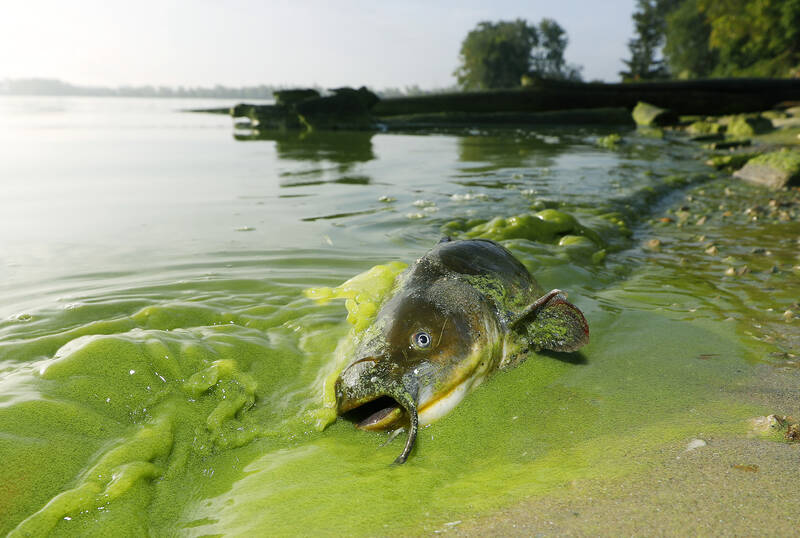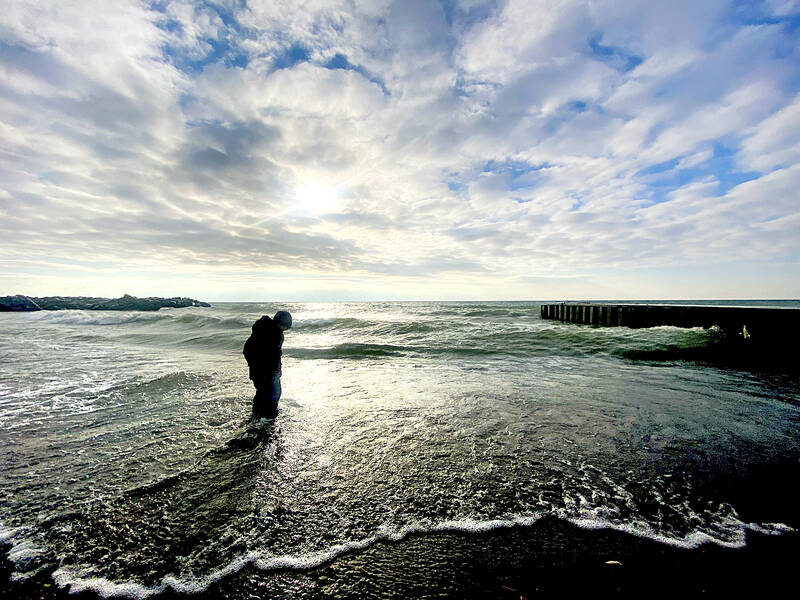The Great Lakes have endured a lot the past century, from supersized algae blobs to invasive mussels and bloodsucking sea lamprey that nearly wiped out fish populations.
Now, another danger: They — and other big lakes around the world — might be getting more acidic, which could make them less hospitable for some fish and plants.
Scientists are building a sensor network to spot Lake Huron water chemistry trends. It’s a first step toward a hoped-for system that would track carbon dioxide and pH in all five Great Lakes over multiple years, said project co-leader Reagan Errera of the National Oceanic and Atmospheric Administration (NOAA).

Photo: AP
“If you change things chemically, you’re going to change how things behave and work and that includes the food web,” said Errera, a research ecologist with NOAA’s Great Lakes Environmental Research Laboratory in Ann Arbor, Michigan.
“Does that mean your favorite fish might not be around any more? We don’t know that, but we know things will change. Maybe where and when they spawn, where they’re located, what they eat.”
ACIDIFICATION

Photo: AP
Oceans are becoming more acidic as they absorb carbon dioxide that human activity pumps into the atmosphere — the primary cause of climate change. Acidification endangers coral reefs and other marine life.
Studies based on computer models suggest the same thing may be happening in big freshwater systems. But few programs are conducting long-term monitoring to find out — or to investigate the ecological ripple effects.
“This doesn’t mean the waters are going to be unsafe to swim in. It’s not like we’re making super acid battery liquid,” said Galen McKinley, a Columbia University environmental sciences professor. “We’re talking about long-term change in the environment that to humans would be imperceptible.”
A 2018 study of four German reservoirs found their pH levels had declined — moving closer to acidity — three times faster in 35 years than in oceans since the Industrial Revolution.
Researchers say Great Lakes also could approach acidity around the same rate as in oceans by 2100. Data from the Lake Huron project will help determine if they’re right.
Two sensors have been attached to a floating weather buoy at Thunder Bay National Marine Sanctuary near Alpena, Michigan. One measures carbon dioxide pressure in the water column and the other pH. Additionally, crews are collecting water samples at varying depths within the 11,137-square-kilometer area for chemical analysis.
Besides disrupting aquatic life and habitat, acidification could deteriorate hundreds of wooden shipwrecks believed resting on the bottom, said Stephanie Gandulla, the sanctuary’s resource protection coordinator and a study co-leader.
Other monitoring stations and sampling sites are planned, Errera said. The goal is to take baseline measurements, then see how they change over time.
Data also is needed from lakes Erie, Michigan, Ontario and Superior, she said. All are part of the world’s largest surface freshwater system but have distinct characteristics, including water chemistry, nutrients and other conditions needed for healthy biological communities.
Acidification from carbon dioxide overload in the atmosphere is different than acid rain caused by sulfur dioxide and nitrogen oxides from fossil fuel burning for electric power generation or manufacturing.
GLOBAL IMPACT
While more potent, acid rain covers relatively small areas and can be reduced with scrubbing equipment, as the US Clean Air Act requires. But the effect of carbon-related acidification is worldwide and potentially more damaging because there’s no easy or quick fix.
“The only solution is a global solution,” McKinley said. “Everyone cuts their emissions.”
Regardless of how well nations accomplish that, big lakes probably will continue acidifying as they absorb carbon dioxide already in the atmosphere, plus carbon-laden water runoff from land, she said.
Less certain are effects on ecosystems, although initial studies have raised concerns.
Based on laboratory tests, scientists who documented soaring acidity in the German reservoirs found it can imperil a type of water flea by hampering defense from predators. The tiny crustaceans are an important food for amphibians and fish.
Scientists in Taiwan experimented with Chinese mitten crabs, an Asian delicacy but an invasive species elsewhere. Increasing water acidity in lab tanks to projected 2100 levels more than tripled their mortality rates, according to a report last year.
Other studies have found freshwater acidification harms development and growth of young pink salmon, also known as humpback salmon, an important commercial and sport fishing species in Alaska and the Pacific Northwest.
But it’s unknown how big such problems will get, said Emily Stanley, a University of Wisconsin freshwater ecology professor.
“I honestly don’t see this as a thing that we as lake scientists should be freaking out about,” Stanley said. “There are so many other challenges facing lakes that are larger and more immediate,” such as invasive species and harmful algae.
The potential upheaval in freshwater ecosystems is one example among many of global warming’s long reach, she said.
“Those greenhouse gases we’re putting into the atmosphere have to go somewhere,” Errera said. “The oceans and large freshwater bodies are where they’re going, and acidification happens as a result.”

On April 26, The Lancet published a letter from two doctors at Taichung-based China Medical University Hospital (CMUH) warning that “Taiwan’s Health Care System is on the Brink of Collapse.” The authors said that “Years of policy inaction and mismanagement of resources have led to the National Health Insurance system operating under unsustainable conditions.” The pushback was immediate. Errors in the paper were quickly identified and publicized, to discredit the authors (the hospital apologized). CNA reported that CMUH said the letter described Taiwan in 2021 as having 62 nurses per 10,000 people, when the correct number was 78 nurses per 10,000

As we live longer, our risk of cognitive impairment is increasing. How can we delay the onset of symptoms? Do we have to give up every indulgence or can small changes make a difference? We asked neurologists for tips on how to keep our brains healthy for life. TAKE CARE OF YOUR HEALTH “All of the sensible things that apply to bodily health apply to brain health,” says Suzanne O’Sullivan, a consultant in neurology at the National Hospital for Neurology and Neurosurgery in London, and the author of The Age of Diagnosis. “When you’re 20, you can get away with absolute

May 5 to May 11 What started out as friction between Taiwanese students at Taichung First High School and a Japanese head cook escalated dramatically over the first two weeks of May 1927. It began on April 30 when the cook’s wife knew that lotus starch used in that night’s dinner had rat feces in it, but failed to inform staff until the meal was already prepared. The students believed that her silence was intentional, and filed a complaint. The school’s Japanese administrators sided with the cook’s family, dismissing the students as troublemakers and clamping down on their freedoms — with

As Donald Trump’s executive order in March led to the shuttering of Voice of America (VOA) — the global broadcaster whose roots date back to the fight against Nazi propaganda — he quickly attracted support from figures not used to aligning themselves with any US administration. Trump had ordered the US Agency for Global Media, the federal agency that funds VOA and other groups promoting independent journalism overseas, to be “eliminated to the maximum extent consistent with applicable law.” The decision suddenly halted programming in 49 languages to more than 425 million people. In Moscow, Margarita Simonyan, the hardline editor-in-chief of the